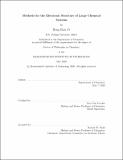| dc.contributor.advisor | Troy Van Voorhis. | en_US |
| dc.contributor.author | Ye, Hong-Zhou,Ph. D.Massachusetts Institute of Technology. | en_US |
| dc.contributor.other | Massachusetts Institute of Technology. Department of Chemistry. | en_US |
| dc.date.accessioned | 2020-09-15T21:57:56Z | |
| dc.date.available | 2020-09-15T21:57:56Z | |
| dc.date.copyright | 2020 | en_US |
| dc.date.issued | 2020 | en_US |
| dc.identifier.uri | https://hdl.handle.net/1721.1/127436 | |
| dc.description | Thesis: Ph. D., Massachusetts Institute of Technology, Department of Chemistry, May, 2020 | en_US |
| dc.description | Cataloged from the official PDF of thesis. | en_US |
| dc.description | Includes bibliographical references (pages 215-236). | en_US |
| dc.description.abstract | An accurate description of the electronic structure of chemical systems is crucial to understanding the atomistic mechanisms of many functional materials and designing new ones. In this thesis, we present methods that can potentially be used to computationally study the electronic structure of large chemical systems. The thesis can be roughly divided into two parts. In the first part, we focus on using quantum embedding (QE) theory to reduce the scaling of traditional electron correlation methods while maintaining their accuracy. Specifically, we extend bootstrap embedding (BE), a QE scheme that has displayed high performance for model Hamiltonians, to general chemical systems. Two challenges arise in such an extension. | en_US |
| dc.description.abstract | First, unlike the model systems, the basis functions of a real chemical system do not possess a uniquely defined connectivity and often lack high symmetries, which pose challenges on partitioning a chemical system into fragments that are necessary for a BE calculation (or other QE schemes). Second, the key to the success of BE on model Hamiltonians is the density matching between fragments that overlap with each other, which requires one to identify fragment centers and edges. Unlike model Hamiltonians where the fragments are regularly shaped -- rendering the identification trivial -- | en_US |
| dc.description.abstract | a real chemical system can have fragments that display complex patterns that make the distinction not obvious. To that end, we propose two fragment choices for partitioning a chemical system, one based on individual orbitals and the other on atoms, and systematically benchmark their effects on the performance of BE. Our finding is that the atom-based fragments are a better choice for BE, leading to fast convergence with the fragment size to the full-system calculations. We then develop an efficient implementation of atom-based BE using coupled cluster with singles and doubles (CCSD) as the local solver, and benchmark it on a series of conjugated molecules containing up to ~ 2900 basis functions. Numerical tests confirm both the accuracy and computational efficiency of BE, rendering it a potential alternative to the more established local correlation methods. | en_US |
| dc.description.abstract | At the end of the first part, we also present another QE scheme, incremental embedding (IE), that does not rely on the connectivity between the units of a system (orbitals or atoms). In the second part, we switch our gear to develop self-consistent methods for locating excited states, which are complementary to the linear response-based methods for excited state calculations. Here, the difficulty is to avoid the variational collapse: unlike the ground state, which is the global minimum of the energy, excited states are often saddle points, making regular algorithms aimed at minimizing the energy collapse down to the ground state. To that end, we propose minimizing the energy variance, which is a minimum for all states and hence promises a numerically robust algorithm for locating them. To target a specific state, we couple the variance minimization to a direct energy-targeting functional. | en_US |
| dc.description.abstract | The resulting method, which we dub [sigma]-SCF, can in principle locate any excited state by specifying a guess of the energy of the state. Numerical tests confirm that [sigma]-SCF solutions behave like the energy-stationary solutions. More importantly, for single excitations, [sigma]- SCF displays the pertinent spin symmetry breaking, which motivates us to improve it using spin projection. This effort leads to the half-projected (HP) [sigma]-SCF, which maintains the ability of [sigma]-SCF to effectively locate excited states, and significantly improves the results for singlet and triplet single excitations. In the conclusion, we comment on how self-consistent excited state methods could be combined with QE, hence enabling large-scale, correlated calculations for excited states. | en_US |
| dc.description.statementofresponsibility | by Hong-Zhou Ye. | en_US |
| dc.format.extent | 236 pages | en_US |
| dc.language.iso | eng | en_US |
| dc.publisher | Massachusetts Institute of Technology | en_US |
| dc.rights | MIT theses may be protected by copyright. Please reuse MIT thesis content according to the MIT Libraries Permissions Policy, which is available through the URL provided. | en_US |
| dc.rights.uri | http://dspace.mit.edu/handle/1721.1/7582 | en_US |
| dc.subject | Chemistry. | en_US |
| dc.title | Methods for the electronic structure of large chemical systems | en_US |
| dc.type | Thesis | en_US |
| dc.description.degree | Ph. D. | en_US |
| dc.contributor.department | Massachusetts Institute of Technology. Department of Chemistry | en_US |
| dc.identifier.oclc | 1192966176 | en_US |
| dc.description.collection | Ph.D. Massachusetts Institute of Technology, Department of Chemistry | en_US |
| dspace.imported | 2020-09-15T21:57:54Z | en_US |
| mit.thesis.degree | Doctoral | en_US |
| mit.thesis.department | Chem | en_US |
